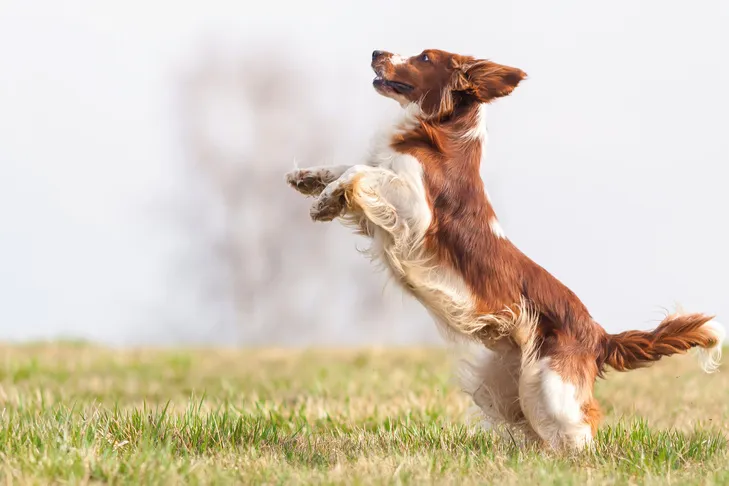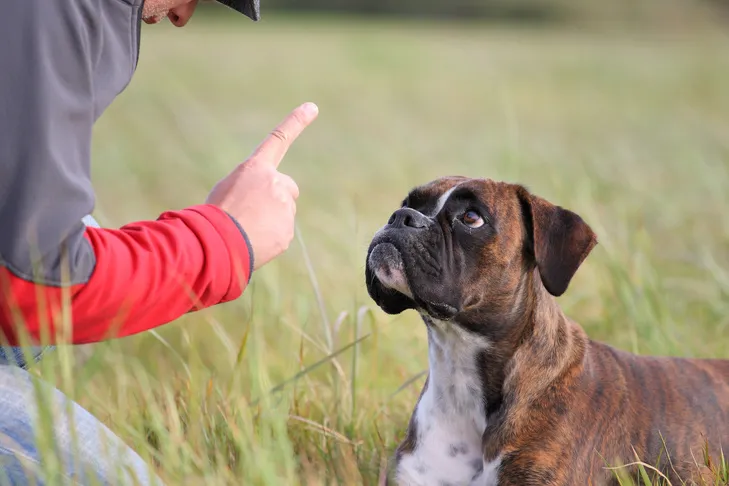Dealing with a dog that jumps up on you or guests can be frustrating, annoying, and even dangerous, especially for children or the elderly who could be knocked over. While your canine companion is often just trying to say “hello” face-to-face or grab your attention, it’s a behavior that needs to be addressed. Jumping is a natural instinct for dogs to greet and seek attention, but it’s not ideal for human interaction. The good news is that you can teach your dog a more appropriate greeting rule, like keeping all four paws on the floor, offering a safer and more polite way to welcome you home.
The AKC GoodDog! Helpline, a trusted resource for dog owners, highlights that teaching an incompatible alternative behavior is the most effective approach to stop jumping. Instead of just telling your dog what not to do, you guide them toward what to do. These 10 tips will help you train your dog to greet people politely and understand exactly how to say “hi” without jumping. This process reinforces positive interactions and strengthens your bond.
1. Only Greet Your Dog When They Have Four Paws on the Floor
The cornerstone of stopping unwanted jumping is to teach your dog an alternative, incompatible behavior. If your dog has all four paws on the floor, they simply can’t jump. This could involve teaching your dog to stand calmly, or perhaps to sit or lie down for greetings. Whatever specific rule you choose, consistency is key. Only provide attention and affection when your dog is following this rule. Avoid sending mixed signals, such as allowing jumping when you’re wearing casual clothes but not when you’re dressed up. Your dog needs a clear, unwavering understanding of the expected behavior.
2. Give Attention As Soon As Your Dog’s Front Feet Hit the Floor
Dogs are intelligent creatures who repeat behaviors that yield desirable outcomes. When your dog successfully adheres to your greeting rule – for example, by keeping their front feet on the floor – immediately reward them with praise and petting. Your attention is a powerful motivator for your dog, so it’s crucial they receive this reward promptly, especially during the learning phase. Delaying your greeting, perhaps to take off your coat or shoes, might lead your dog to become impatient and revert to jumping as a way to gain your notice. Swift positive reinforcement ensures your dog associates the correct behavior with the desired outcome.
3. Remove Attention When Your Dog Jumps
Conversely, to eliminate jumping, you must stop rewarding it entirely. Never reinforce a behavior you wish to extinguish. If your dog jumps on you, immediately withdraw the attention they are seeking. This can be as simple as turning your back or calmly walking away. This action teaches your dog that jumping achieves the opposite of their intention. The moment your dog returns to the “four on the floor” position, promptly turn back and offer quiet praise and gentle petting. This consistent response helps your dog understand that their behavior acts like a switch, turning your attention on and off.
 Welsh Springer Spaniel jumping up outdoors.
Welsh Springer Spaniel jumping up outdoors.
4. Set Up Your Dog for Success
While ignoring jumping and rewarding proper greetings is effective, it can be a trial-and-error process that might be frustrating for your dog. You can expedite their learning by making it easier for them to succeed. If your chosen greeting rule is for your dog to sit, cue them to sit the moment you enter the door. If “four on the floor” is the goal, encourage them to remain standing calmly.
A clever technique to prevent jumping is to scatter small treats on the floor. Most dogs find free goodies irresistible, and they cannot jump while simultaneously sniffing and consuming treats from the ground. Be quick to provide the food before your dog even considers jumping, effectively rewarding the “four on the floor” behavior with both attention and a delicious incentive. As your dog grasps the greeting rule, you can gradually reduce the reliance on food rewards. You can also explore methods for teaching a puppy to come on command to enhance their responsiveness.
5. Always Reward Your Dog for Proper Greeting Behavior
Your dog will learn appropriate greeting behaviors more rapidly if their actions have an immediate and consistent impact on your attention. Keeping all four feet on the floor should consistently earn your attention, while jumping should always result in its removal. Therefore, it is imperative that you always reward your dog when they follow your established greeting rule. Even if you feel exasperated after a prolonged period of jumping, do not withhold your attention once your dog’s feet return to the floor. Inconsistent reinforcement will only confuse your dog and hinder the training process, making it harder for them to understand what is expected.
6. Don’t Grab or Push Your Dog Away
It’s important to remember that your dog jumps to get your attention. Even a negative physical response, such as grabbing their paws, holding them, or pushing them away, still constitutes attention in your dog’s mind and inadvertently rewards the jumping behavior. This can lead to an increase, rather than a decrease, in jumping over time. Worse still, for many dogs, this kind of physical interaction can be misinterpreted as an invitation for roughhouse play. They might then return to jumping with even greater intensity, believing it to be part of an engaging game. For foundational training, consider resources on how to teach come to a puppy.
 American Hairless Terrier jumping up on the leg of its owner outdoors.
American Hairless Terrier jumping up on the leg of its owner outdoors.
7. Don’t Put Your Knee Up When Your Dog Jumps
A common, but misguided, piece of advice is to raise your knee to block your dog’s chest when they jump. As previously discussed, such physical contact can be misinterpreted by some dogs as an invitation to a wrestling match or a form of attention, potentially exacerbating the jumping behavior. More critically, for the majority of dogs, this action can erode trust and damage the crucial human-canine bond. Your dog is merely attempting to greet you, and responding with a physical block can be perceived as punishment. This could even lead to injury for your dog. A fractured trust can manifest in other behavioral issues, such as a reluctance to come when called.
8. Keep Greetings Low-Key While Your Dog Is Learning
Dogs, particularly when excited, can struggle with self-control. It takes considerable emotional self-control for your dog to resist the natural urge to jump and instead follow a new greeting rule. You can make this process easier by keeping greetings calm and subdued, especially during the initial learning phase. Dogs are adept at reading our emotions; if you appear overly excited, your dog is likely to mirror that enthusiasm, making it harder for them to control their impulses. Instead, maintain a calm and quiet demeanor, even when offering praise. As your dog begins to understand and apply the new rule, you can gradually increase your own excitement level until you can greet them with enthusiasm without triggering a jumping response. This method helps your dog grasp the concept of “calm greetings.”
9. Prevent Your Dog From Jumping on Guests
Your dog’s behavior isn’t solely reinforced by you. Other family members, guests, and even strangers encountered outside can inadvertently reward jumping if preventative measures aren’t taken. To manage this, employ techniques such as keeping your dog on a leash when visitors arrive, preventing them from directly approaching. An even more effective strategy is to send your dog to their designated “place”, such as a mat or bed, or to place your dog in their crate so they are away from the entry point. Utilizing a baby gate to block access to the front hall can also be a simple and effective management tool, ensuring a controlled environment for greetings. Learning how do i teach my puppy to come can be beneficial for managing their presence around guests.
 Boxer laying down outdoors being trained by a man.
Boxer laying down outdoors being trained by a man.
10. Ask Guests and Strangers to Follow Your Greeting Rule
Don’t hesitate to clearly communicate with guests and strangers about the appropriate way to interact with your dog. While your dog is still learning, politely ask people to completely ignore your dog unless you indicate it’s acceptable to greet them. It’s also wise to avoid interactions with unfamiliar individuals until your dog has consistently mastered polite greetings with friends and family who you know will cooperate with your training methods. When encountering strangers, you can use a “watch me” cue or distract your dog with a hand touch or a favorite toy until the person has passed. Consistent practice with controlled greetings will lead to more reliable behavior. For related training on teaching a puppy to come and stay, you can consult articles like how to teach puppy to come and stay and teaching puppy to come to you.
Successfully stopping your dog from jumping requires patience, consistency, and a clear understanding of canine behavior. By implementing these 10 tips, you can effectively teach your dog appropriate greeting manners, fostering a more harmonious relationship and ensuring everyone’s safety. If you encounter persistent challenges or require further expert guidance, resources like the AKC GoodDog! Helpline offer personalized assistance with various dog training questions, from puppy training to addressing unwanted behaviors in older dogs.
